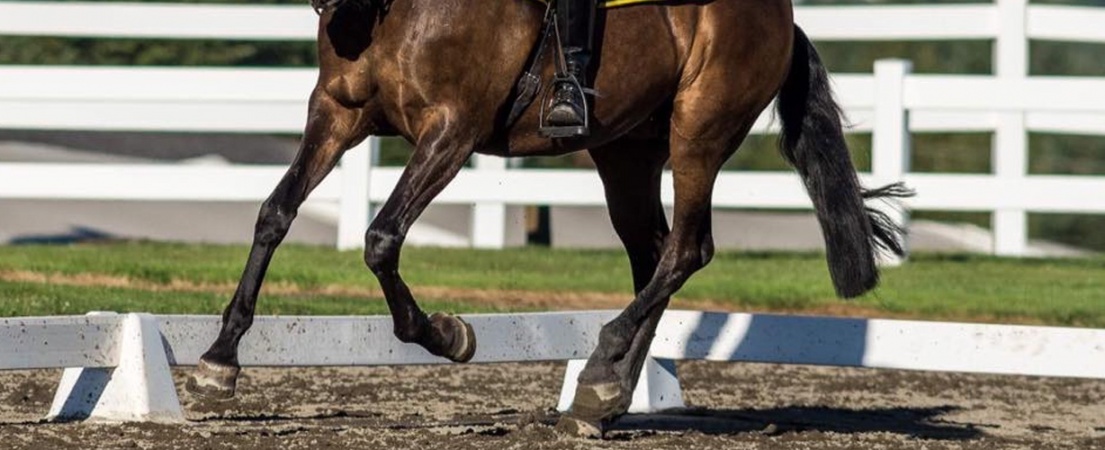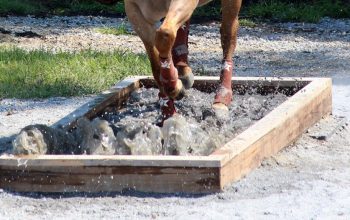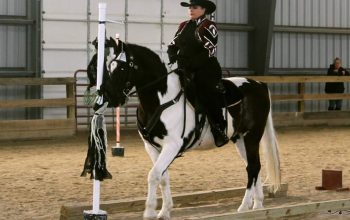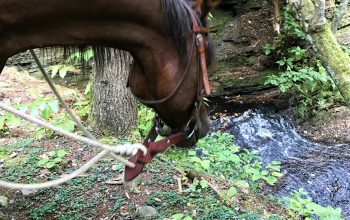By Kim Peterson

In the sport of working equitation, as with most equestrian pursuits, less is more.
Barely visible aids are what I aspire to apply when I perform the spicy dance of working equitation. I need to take responsibility for my body language and be listening to my horse. To be a good dance partner, I must prepare for each move. This enables us to glide from each movement or gait to the next with fluidity and harmony.
As riders, we need to carry ourselves in a manner that allows our horse to work underneath us to their full potential. If our body is aligned with a straight line between the shoulder, hip and heel we are in the optimum position to apply the aids and carry ourselves lightly when asking our horse to perform the obstacles or maneuver through the dressage test.
Often, I see riders in what I call an armchair seat, where the rider’s shoulder and hips are in line and their heels are much further forward. In this position, the rider tends to sit much heavier in the saddle, and it takes much longer to apply a leg aid, as the lower legs need to move back to reach the horse’s sides. Horses sometimes react fearfully if the leg is nowhere near their sides and then suddenly “bang” there they are. When riding in the armchair position, the rider is likely to overuse their seat as a forward driving aid: This may result in the horse dropping his back and trailing the hocks out the back. This way of going is the exact opposite of what we are working toward.

It is easy to check the shoulder, hip, heel line by simply dropping your arm by your side and looking down your arm to check if you are correctly aligned.
A rider that grips tightly through the knee and thigh will tend to have a loose lower leg, their heels will ride up, and they will ride in a toe-down manner. We need to ride with our heels softly lower than the toe but not jammed down where the rider’s muscles become taut and they can no longer tone the calf muscles up or soften them when applying barely visible aids. A rider who travels with the toes down tends to go to their spur to apply the leg aids. When applying the aids in this manner, your horse will become flat and unresponsive to the leg aids, resulting in riders heading toward sharper spurs.
This is not true to the spirit of working equitation and is not in the best interest of the horse/human partnership. I like to ride with my legs hanging gently on the horse’s sides where I am able to tone up my muscles to give an almost invisible aid which my horses respond to immediately and calmly.
A rider that is tight around the knee will perch up high above the horse and may lose balance easily. I thought my balance was pretty good until I was given a lesson on the lunge in Germany, I had to perform a group of coordinated exercises up there. That sure was an eye opener! Performing exercises whilst being lunged certainly is a great tool, which we could utilize more often.
In the sport of working equitation we are striving for a harmonious partnership whilst performing lines and obstacles with no resistance. With good preparation on approach to the obstacles you give your horse the best opportunity to reach the elusive score of ten. By using your eyes to look ahead and performing numerous half halts to increase the engagement and balance of the horse, you will execute a good line. With good preparation, you can avoid sharp turns and overshooting the entry to the obstacles. I often see riders looking down and not planning their line to the obstacle, then suddenly applying a harsh aid to turn and the horse reacts by opening its mouth or other forms of resistance. This may result in your horse losing confidence and certainly a poor score. Many riders tend to hang on the inside rein. The inside rein is the directional rein, and we ask for bend and flexion with this rein. Once the horse is bending, we should give the horse the job of maintaining the bend. As riders, we take on too much of the responsibility in the partnership with our horse. To achieve unity we must give our horse the opportunity to play a bigger role and balance out the relationship.
I see some riders stuck on the inside rein and never softening, this restriction brings about resistance and the horse will tighten through the shoulders and jaw. Often the rider who fails to soften the inside rein will have an inconsistent contact on the outside rein. The outside rein is your brake rein and also controls the degree of bend. It is important to maintain a light interpretive contact on the outside rein to encourage your horse to travel with straightness. In saying this, the rider who hangs on the outside rein too tightly will prevent the horse from bending to the inside.
Listen to the Best Teacher
If you are a good listener, your horse will let you know when you are not maintaining a good balance between the leg and hand. The horse is the best teacher of all.
Many years ago, when I was first learning dressage my coach would yell “More leg, more leg!” I was told to squeeze every stride. I am not the sharpest tool in the shed, so it took me quite a while to realize my horses were becoming flat to my leg and some were even sour to the leg aid. Learn by my mistakes; ask the question quietly with your leg. If your horse does not respond, you can back up the leg aid with the whip or spur. Next time you ask the question, give your horse the opportunity to respond to a light squeeze with your calf and expect him to readily respond. When training on an obstacle and the horse does not immediately respond to the aids, please do not start bullying him and getting rough. Take time to look back at yourself and ask “am I presenting the question in a way that the horse can understand? Am I using my body in a way that helps the horse or am I getting in his way?”
Less is more!
The sport of working equitation is built around honoring the noble horse. We achieve this by becoming good communicators. Horses communicate energetically. If you have clear intentions, your horse will answer your questions before you apply the physical aids. Now that is true unity! A rider who is a good listener, remains focused and calm, is well equipped to lead their horse beautifully through the spicy dance of working equitation.
Kim Peterson, Working Equitation trainer, competitor, coach, and judge came to the sport with a wealth of previous experience in other disciplines in her homeland of Australia. In addition to dressage, camp drafting (similar to a ranch horse versatility competition here in the United States), and trick riding, she and her students have competed successfully in Working Equitation since the sport was first brought to Australia.
 For more information about
For more information about
Working Equitation, please visit
our website: www.WEUnited.us.




